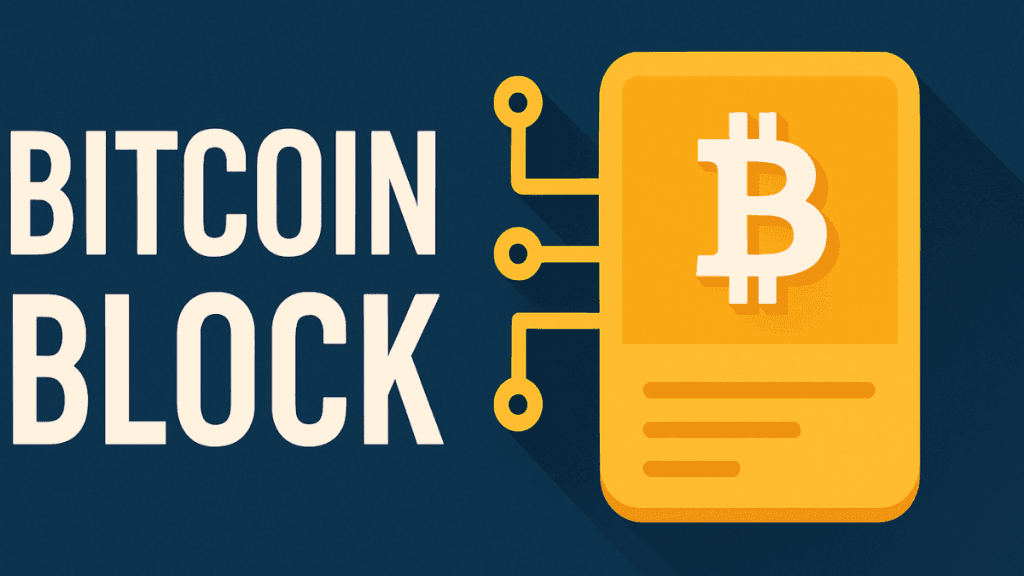Understanding how a Bitcoin Block works is the first step to understanding how Bitcoin itself functions. Without blocks, the Bitcoin network cannot process transactions, maintain security, or operate as a decentralized currency.
In this guide, we break everything down in simple English while keeping the explanation accurate, trustworthy, and actionable.
What Is a Bitcoin Block?
A Bitcoin Block is a package of transaction data that is added to the Bitcoin blockchain. Think of it like a page in a digital ledger. Each page contains verified transactions, and once a block is added, it cannot be changed. This is what keeps Bitcoin secure and trustworthy.
A block contains:
- A list of Bitcoin transactions
- A timestamp
- A reference (hash) to the previous block
- A unique block hash
- A nonce used for Proof of Work
- The block reward (new bitcoins created)
Each new block strengthens the chain, making it harder for anyone to tamper with the past.
Why Bitcoin Uses Blocks
Bitcoin uses blocks to:
- Organize transactions
- Prevent double-spending
- Maintain decentralization
- Distribute new bitcoins (through mining rewards)
- Secure the network using cryptography
Blocks are the building units that make the entire system work. Without them, the network would not have a reliable way to record who owns what.
How a Bitcoin Block Is Created
Creating a block involves several steps that make the Bitcoin network decentralized and tamper-proof. Here’s how the process works in simple terms:
1. Collecting Transactions
When people send Bitcoin, those transactions go into a pool called the mempool. Miners choose which transactions to include in the next block. Usually, they prioritize transactions with higher fees.
2. Organizing the Transactions
The miner bundles transactions and adds a special transaction called the coinbase transaction, which creates new bitcoins as the block reward.
3. Building the Block Header
The block header includes:
- Timestamp
- Previous block hash
- Merkle root (summarizes all transactions)
- Nonce
- Version number
- Difficulty target
4. Proof of Work (PoW)
This is the most energy-intensive step.
Miners compete to find a value (nonce) that produces a block hash that meets the network’s difficulty target. This process is like solving a cryptographic puzzle.
5. Broadcasting the Block
Once a miner solves the puzzle:
- The block is broadcast across the Bitcoin network.
- Other nodes verify the block.
- If valid, it gets added to the blockchain.
The miner receives the block reward + transaction fees.
What Is Inside a Bitcoin Block? (Simple Breakdown)


Each block contains several components that work together to secure the blockchain.
1. Block Header
This holds meta-information, such as:
- Hash of previous block
- Merkle root
- Timestamp
- Difficulty target
- Nonce
2. Block Body
This is where the real action is. It includes:
- All verified transactions
- Coinbase transaction (newly mined bitcoins)
3. Block Hash
This is the fingerprint of the block. If any detail in the block changes, even slightly, the hash changes completely — making tampering impossible.
Block Size and Block Time
Block Size
Bitcoin’s block size is roughly 1 MB, though upgrades such as SegWit allow more efficient storage of data.
Block Time
A new block is added every 10 minutes on average.
This timing is controlled automatically by adjusting mining difficulty.
Bitcoin Block Difficulty
To maintain a stable block time of 10 minutes, Bitcoin adjusts the mining difficulty every 2016 blocks (about two weeks). If blocks were discovered too fast, the difficulty increases. If too slow, it decreases.
Difficulty ensures:
- Consistent block generation
- Fair miner competition
- Network stability
Block Rewards and Halving
When a miner adds a new block, they receive:
- Block reward (new bitcoins)
- Transaction fees
The block reward halves every 210,000 blocks (about every four years). This event is called the Bitcoin Halving.
Year | Block Reward |
2009 | 50 BTC |
2012 | 25 BTC |
2016 | 12.5 BTC |
2020 | 6.25 BTC |
2024 | 3.125 BTC |
This halving mechanism ensures Bitcoin’s supply remains limited at 21 million.
The Role of the Merkle Tree in a Bitcoin Block
A Merkle tree summarizes all transactions inside a block using hashes. It allows Bitcoin to:
- Verify transactions efficiently
- Reduce data size
- Maintain blockchain integrity
The Merkle root (top hash) is stored in the block header.
Why Blocks Are Linked: The Blockchain Concept
Each Bitcoin block references the hash of the previous block. This creates a chain of blocks, which is where the term blockchain comes from.
If someone tries to change a past block:
- Its hash changes
- All future blocks become invalid
- The network rejects the tampering
This structure makes Bitcoin nearly impossible to alter once blocks are confirmed.
What Happens When Two Blocks Are Found at the Same Time?
Sometimes, two miners solve a block almost simultaneously. This creates a temporary fork.
Nodes follow the longest chain rule:
- The chain with the most accumulated Proof of Work becomes the valid chain.
- The shorter one becomes an orphaned block.
This process ensures the blockchain remains consistent.
How Many Transactions Fit in a Block?
A typical Bitcoin block holds around 1,500 to 2,500 transactions, depending on size and structure.
With SegWit, more transactions fit in each block.
Why Bitcoin Blocks Make the Network Secure
Bitcoin blocks protect the system by:
1. Making data immutable
Once a block is added, it cannot be changed without redoing all the work that followed.
2. Decentralizing verification
Anyone can run a node and verify blocks themselves.
3. Preventing double-spending
Transactions are locked in the blockchain and cannot be reversed.
4. Creating economic incentives
Miners earn rewards, encouraging them to secure the network honestly.
Common Myths About Bitcoin Blocks
Myth 1: Blocks contain coins
False. Blocks contain transaction records, not actual coins.
Myth 2: Blocks can be edited later
Impossible. Changing a block would break the entire chain.
Myth 3: Blocks instantly confirm transactions
A transaction is only final after multiple confirmations, typically 3 to 6.
Future of Bitcoin Blocks
Bitcoin blocks may evolve through improvements like:
- Better compression techniques
- Layer-2 scaling (Lightning Network)
- Potential soft forks for efficiency
- Continuous improvements in mining hardware
But the core block structure will likely remain unchanged to preserve decentralization.
Final Thoughts
A Bitcoin Block is not just a technical concept. It is the foundation that keeps Bitcoin secure, decentralized, and functional. By understanding how blocks work, you know how Bitcoin operates at its core. Each block represents trust, transparency, and a new step in the digital financial revolution.
If you master the idea of blocks, you’ll have a strong foundation for exploring mining, blockchain development, technical trading, or full node operation.
